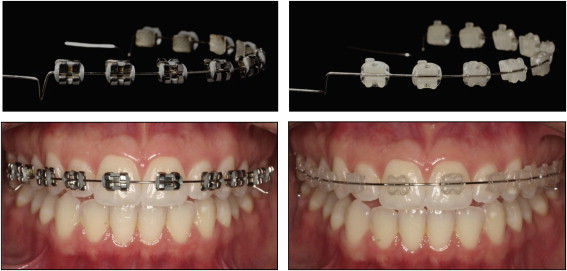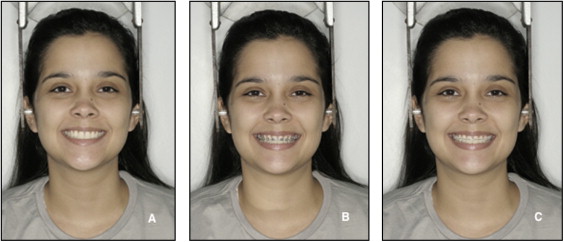Introduction
Physical attributes, behavior, and personal ornaments exert a direct influence on how a person’s beauty and personality are judged. The aim of this study was to investigate how people who wear a fixed orthodontic appliance see themselves and are seen by others in social settings.
Methods
A total of 60 adults evaluated their own smiling faces in 3 different scenarios: without a fixed orthodontic appliance, wearing a metal fixed orthodontic appliance, and wearing an esthetic fixed orthodontic appliance. Furthermore, 15 adult raters randomly assessed the same faces in standardized front-view facial photographs. Both the subjects and the raters answered a questionnaire in which they evaluated criteria on a numbered scale ranging from 0 to 10. The models judged their own beauty, and the raters assigned scores to beauty, age, intelligence, ridiculousness, extroversion, and success.
Results
The self-evaluations showed decreased beauty scores ( P <0.0001) when a fixed orthodontic appliance, especially a metal one, was being worn. There was no statistically significant difference between the 3 situations in the 6 criteria analyzed.
Conclusions
A fixed orthodontic appliance did not affect how personal attributes are assessed. However, fixed orthodontic appliances apparently changed the subjects’ self-perceptions when they looked in the mirror.
Adolescents apparently do not object to wearing braces. Adults, however, express varying degrees of dissatisfaction, indicating that they do care about social judgments about wearing a fixed orthodontic appliance. This concern stems in part from the fact that the face is the main focus of attention during social interactions. Furthermore, laypeople assess dental appearance and form social judgments based on physical attributes. This behavior can potentially restrict access by part of the population to the benefits of orthodontic treatment.
Although a beautiful face and smile do exert considerable influence on how people are perceived and on how their social and professional skills are assessed, there is still some controversy about whether a fixed orthodontic appliance per se negatively impacts facial esthetics and other attributes of adults undergoing orthodontic treatment. Thus, in this study, we aimed to evaluate how a person’s age, intelligence, ridiculousness, extroversion, and success are judged when he or she is wearing a metal or an esthetic fixed orthodontic appliance. These appliances were chosen because they are most commonly used by patients worldwide; these patients needed to be compared with those not having treatment to improve their smile.
Material and methods
This cross-sectional study included 60 volunteers who served as subjects. The group comprised 21 men and 39 women, ages 18 to 47 years, whose maxillary dentition was complete, with both dental arches either aligned or having mild crowding. All subjects signed a form of free and informed consent, and the study was approved by a research ethics committee, under registration number CONEP-CAAE: 0034.0.368.000-11.
Brackets were positioned but not bonded to ensure that the smiles with metal and esthetic appliances were obtained without damage to the enamel surfaces. A 0.018-in stainless steel archwire (Morelli, Sorocaba, São Paulo, Brazil), in coordination with the maxillary dental arch, was used to stabilize the brackets. The terminal portion of the archwire was bent occlusally to allow the volunteers to occlude and stabilize it, mimicking the appearance of a bonded appliance ( Fig 1 ). All bracket bases were in contact with the buccal surfaces of the teeth.

The models made self-assessments looking at themselves in a mirror in these 3 conditions: without a fixed orthodontic appliance, with polycrystalline ceramic brackets (ICeram, Orthometric, Ma’anshan, China) on the maxillary teeth and esthetic elastic ligatures (Morelli), and with metal brackets (Morelli) on the maxillary teeth tied with gray elastic ligatures (Morelli). Thereafter, the subjects filled out analog scales on paper, assigning self-perception scores of beauty from 0 to 10 (“not beautiful at all” to “very beautiful”) to their faces in the 3 situations above.
Three color digital photographs were taken of each subject’s face with and without metal and esthetic appliances. All photographs showed a front view of their smiling faces while they were seated and positioned in a cephalostat. The models were told to smile with their teeth in occlusion, thereby stabilizing the appliance so that the maxillary teeth were shown with minimal exposure of the mandibular incisors. Spectacles, earrings, and necklaces were removed, and subjects with long hair were instructed to pull it back so that only the face was brought into focus ( Fig 2 ). All wore an ordinary gray T-shirt because clothing affects how one evaluates photographs. The color gray was preferred because it minimizes any potential contrast between skin color and shirt.

Next, these photographs were analyzed by 15 adult raters who were laypeople not currently undergoing orthodontic treatment. To make this possible, a Web site was created and set up so that the images appeared one at a time, with only one question being answered each time. Furthermore, the users were allowed to access and exit the Web site by logging in with a password for as long and as often as they wished. The 180 photographs of the 60 subjects were randomly ordered by lot. When the interval between photographs of the same subject fell below 25 photographs, the photographs were once again selected by lot.
Initially, all images were judged in the age category, and then the same sequence of photos was repeated for judgments of beauty, intelligence, ridiculousness, extroversion, and success. Age was judged by assigning a number of years, and the other categories were assigned scores ranging from 0 to 10: ie, from “not beautiful at all” to “very beautiful,” “not intelligent at all” to “very intelligent,” “not ridiculous at all” to “extremely ridiculous,” “not extroverted at all” to “very extroverted,” and “very unsuccessful” to “very successful.”
Thus, for each feature that was assigned a score, the rater’s mean score was included in the statistical analysis. That is, each face was assigned 1 final score used for each criterion that was the result of the mean scores assigned by the raters. The sampled variables were subjected to descriptive statistics. Analysis of variance (ANOVA) for repeated measures was used to test the hypothesis of no difference between faces with different brackets vs no appliance. ANOVA was also used to test whether there were differences in the beauty scores assigned through self-evaluation. Where appropriate, the Tukey-Kramer multiple comparisons test was applied. The Student t test was used to check whether there was any difference between the scores of self-perceived beauty and the data from the raters. The significance level was set at 5%.
Results
Descriptive statistics and the ANOVA results are shown in Table I . In the self-evaluations of beauty, there were differences between the 3 smiling faces. The models saw themselves as more beautiful when not wearing a fixed orthodontic appliance, followed by when wearing an esthetic fixed orthodontic appliance, and finally a metal fixed orthodontic appliance ( P <0.0001). For the scores assigned by the raters on the Web site, no statistically significant difference was found for any criterion: without brackets or wearing metal or esthetic fixed orthodontic appliances. The ANOVA test had a power of .98 (alpha = .05; SD = 0.67; difference to detect = 1.0).
| Variable | Smiles | ||||||
|---|---|---|---|---|---|---|---|
| No FOA | Metal FOA | Esthetic FOA | |||||
| Mean | SD | Mean | SD | Mean | SD | P | |
| Beauty self-evaluation | 7.40 a | 1.57 | 5.15 b | 2.25 | 6.20 c | 1.63 | <0.0001 ∗ |
| Beauty | 5.30 | 1.75 | 4.87 | 1.71 | 5.02 | 1.61 | 0.1918 |
| Age | 24.53 | 0.45 | 24.27 | 0.42 | 24.46 | 0.44 | 0.9160 |
| Intelligence | 6.94 | 0.08 | 6.82 | 0.08 | 6.89 | 0.08 | 0.6195 |
| Ridiculousness | 2.98 | 0.09 | 3.24 | 0.08 | 3.20 | 0.09 | 0.0932 |
| Extroversion | 5.95 | 0.11 | 5.74 | 0.11 | 5.83 | 0.10 | 0.4230 |
| Success | 6.57 | 0.11 | 6.27 | 0.10 | 6.39 | 0.09 | 0.1131 |
Stay updated, free dental videos. Join our Telegram channel

VIDEdental - Online dental courses


